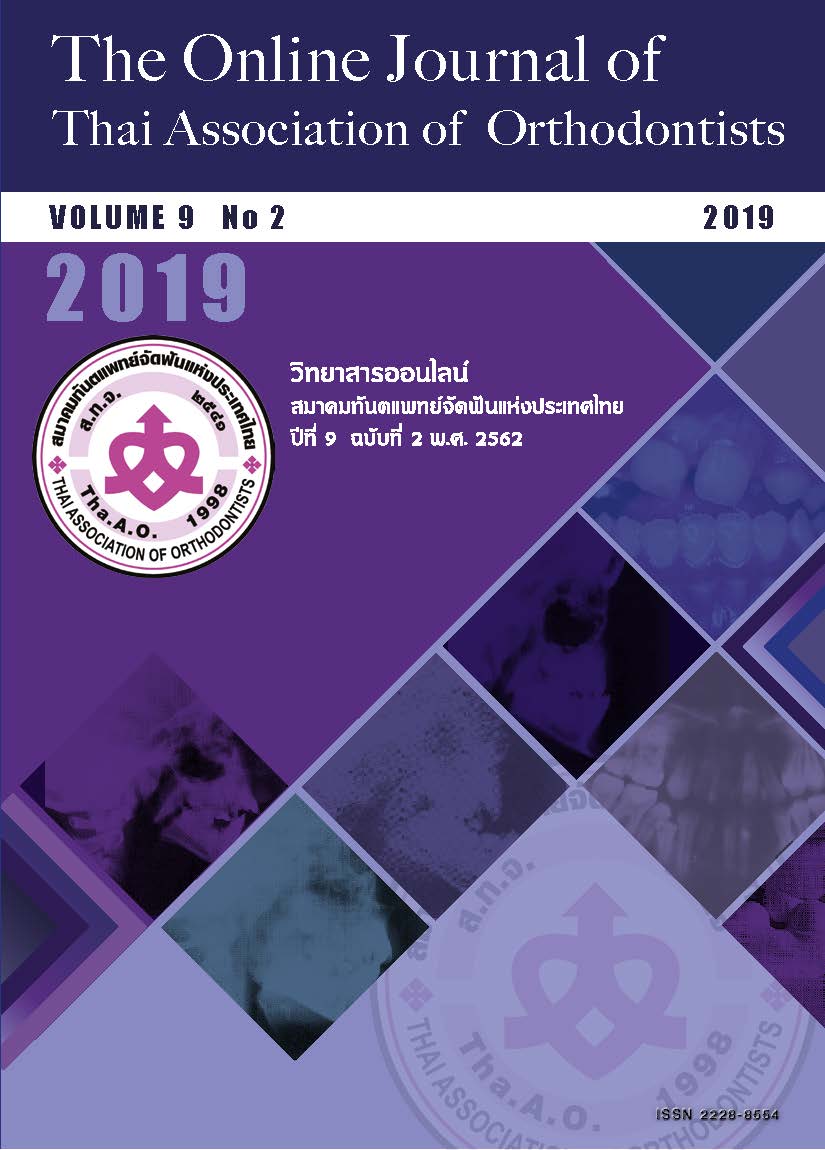Comparisons of the Chondroitin Sulphate Levels and the Amount of Pain during Initial Orthodontic Leveling Phase between Passive Self-ligating and Conventional Bracket Systems
Main Article Content
Abstract
Purpose: To compare chondroitin sulphate (CS) levels in gingival crevicular fluid (GCF) and the amount of pain (between before loading and the loaded periods) during initial orthodontic leveling phase between passive self-ligating and conventional bracket systems.
Materials and methods: Thirteen patients (3 males and 10 females; aged 19.28 ± 2.28 years) who required non-extraction orthodontic treatment were recruited. Passive self-ligating (Damon®3MX) (as experimental) and conventional brackets (Mini diamond®) tied with elastomeric ligature (as control) (0.022 x 0.028 inch bracket slots) were randomly assigned and bonded to either right or left maxillary seven-tooth segment (using a split mouth technique). Orthodontic leveling was carried out using 0.014 inch diameter Copper Nickel Titanium wire. GCF samples around the left and right maxillary canines and first premolars were collected using PERIOPAPERTM strips before loading (as baseline data) and during the loaded periods (on days 1, 3, 5, 7, 14, 21 and 28 as experimental data). The CS levels in GCF were measured by competitive ELISA with WF6 monoclonal antibody and were compared between the passive self-ligating and the conventional bracket systems during orthodontic leveling by the Mann-Whitney U-test. The differences in the CS levels in GCF between before loading and during the loaded period using either the passive self-ligating or the conventional bracket system were analyzed using the Wilcoxon signed-rank test. VAS scores were used to evaluate the patients’ discomfort every visit between passive self-ligating and conventional bracket systems during orthodontic leveling. The differences in VAS scores during each experimental period were determined by the Mann-Whitney U-test.
Results: For the canines during the loaded periods bonded with the conventional bracket system, the medians of CS levels during the loaded period were significantly higher than those at baseline. For the canines bonded with the passive self-ligating bracket system and the first premolars (bonded using either the self-ligating or the conventional bracket system) during the loaded period, the medians of CS levels were insignificantly higher than those at baseline. For both the canines and the premolars (bonded with either the passive self-ligating or the conventional bracket system), the medians of CS levels during the loaded period were not significantly different. The median of the VAS scores for patients’ discomfort with conventional bracket were insignificantly greater than that with passive self-ligating bracket.
Conclusion: During initial orthodontic leveling phase, both the passive self-ligating and the conventional bracket systems caused similar alveolar bone remodeling as revealed by similarly raised CS levels in GCF. However, the passive self-ligating bracket system might cause less pain and better comfort, though insignificantly, than did the conventional bracket system.
Article Details

This work is licensed under a Creative Commons Attribution-NonCommercial-NoDerivatives 4.0 International License.


